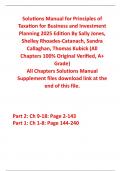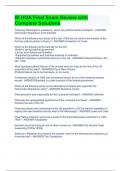Solu�ons Manual for Principles of
Taxa�on for Business and Investment
Planning 2025 Edi�on By Sally Jones,
Shelley Rhoades-Catanach, Sandra
Callaghan, Thomas Kubick (All
Chapters 100% Original Verified, A+
Grade)
All Chapters Solutions Manual
Supplement files download link at the
end of this file.
Part 2: Ch 9-18: Page 2-143
Part 1: Ch 1-8: Page 144-240
, Part 2
Chapter 9: Nontaxable Exchanges
Questions and Problems for Discussion
1. Although Company PJ must have expended $700,000 for the 1,000 acres, it did not take a cost basis
in the land. Instead, PJ took a substituted basis of only $475,000 (basis of the property PJ
surrendered in the nontaxable exchange). Therefore, PJ’s recognized gain on sale of the land will
exceed the $600,000 appreciation by $225,000.
2. Because of the value-for-value presumption, the amounts realized by unrelated parties on the
exchange of property are always equal.
3. The tax consequences to unrelated parties engaging in a nontaxable exchange are completely
independent. For instance, one party could have a partially recognized gain while the other party
could have an unrecognized loss.
4. The substituted basis of the qualifying property received in a nontaxable exchange can be more, less,
or equal to the cost of the property, depending on the gain or loss deferred on the exchange.
5.
a. If Firm A is transacting with the KLS Partnership itself, the contribution of property (the 2 percent
interest in the MG Partnership) for a 10 percent equity interest in KLS is nontaxable to both Firm
A and KLS Partnership. However, if the other party is a partner in KLS (not the partnership), the
exchange is taxable to both parties.
b. Mr. B’s exchange of land for RV stock is taxable to Mr. B but nontaxable to RV.
c. Corporation C’s exchange of personalty for realty is taxable to both parties.
d. Company D’s exchange of inventory for a new computer system is taxable to Company D. Not
enough information is provided to determine if the exchange is taxable to the other party.
6. Because Firm Q is exchanging inventory for land, the exchange is taxable to Firm Q. Because
Company M is exchanging business realty for investment realty, the exchange is a nontaxable, like-
kind exchange to Company M.
7. Company W exchanged marketable securities for $250,000 of the $2 million FMV of Blackacre: this
exchange does not qualify as a like-kind exchange. Consequently, Company W recognizes a
$220,000 capital gain on the exchange.
8. If the value of the destroyed property exceeds the insurance reimbursement and the insurance
reimbursement exceeds the property’s adjusted basis, the owner suffers an economic loss but
realizes a gain.
9. A transfer of property to a corporation in exchange for the corporation’s stock is nontaxable only if the
transferor (or group of transferors) owns 80 percent or more of the corporation immediately after the
exchange. A transfer of property to a partnership in exchange for an equity interest is nontaxable
regardless of the extent of the transferor’s ownership after the exchange.
10. An asset has a substituted basis if the current owner’s basis is determined by reference to the basis
of a different asset disposed of by the owner. An asset has a carryover basis if the current owner’s
basis is the same as the basis of the asset in the hands of a previous owner.
© McGraw Hill LLC. All rights reserved. No reproduction or distribution without the prior written consent of McGraw Hill LLC.
9-1
,11. For financial statement purposes, gain or loss realized on the exchange of one asset for another is
usually included in current year income, even if the gain or loss is not recognized for tax purposes.
The book/tax difference is temporary because the unrecognized gain or loss is merely deferred, not
eliminated.
12. The taxpayer takes a substituted basis in the newly issued stock so that the deferred gain (equal to
the unrealized appreciation in the transferred property) is embedded in the stock. However, the
corporation takes a carryover basis in the property so that the corporation will recognize the
unrealized appreciation on subsequent disposition of the property. Thus, both the shareholder and
the corporation have deferred gain with respect to their new assets.
13. Congress has no quarrel with taxpayers who sell securities at a gain, then immediately reacquire the
securities. This strategy accelerates the recognition of income and the payment of tax on that income.
14. Firm B should sell the block of stock with the less volatile market price to minimize the risk of a
significant price increase between date of sale and date of reacquisition.
15. Gain or loss realized on a nontaxable exchange is not eliminated but merely deferred until the
taxpayer disposes of the property received in the exchange in a taxable transaction.
Application Problems
1.
a. Realized gain $6,700 ($16,000 amount realized − $9,300 tax basis); recognized gain $6,700; tax
basis in new asset $16,000 cost.
b. Realized gain $6,700 ($16,000 amount realized − $9,300 tax basis); recognized gain -0-; tax
basis in new asset $9,300 substituted basis.
c. If the exchange was taxable, gain recognized on sale of the new asset is $850 ($16,850 amount
realized − $16,000 tax basis). If the exchange was nontaxable, gain recognized on sale of the
new asset is $7,550 ($16,850 amount realized − $9,300 tax basis).
2.
a. Realized loss $12,000 ($95,000 amount realized − $107,000 tax basis); recognized loss $12,000;
tax basis in new asset $95,000 cost.
b. Realized loss $12,000 ($95,000 amount realized − $107,000 tax basis); recognized loss -0-; tax
basis in new asset $107,000 substituted basis.
c. If the exchange was taxable, gain recognized on sale of the new asset is $5,000 ($100,000
amount realized − $95,000 tax basis). If the exchange was nontaxable, loss recognized on sale of
the new asset is $7,000 ($100,000 amount realized − $107,000 tax basis).
3.
a. Rufus must pay $12,500 boot in addition to transferring property with a $77,500 FMV. The total
amount transferred to Hardy must be $90,000, which is the FMV of the property Hardy transfers
to Rufus.
b. Rufus realizes a $27,500 gain ($90,000 amount realized − [$50,000 tax basis of transferred
property + $12,500 boot paid]). Rufus recognizes no gain because it did not receive boot. Its
basis in the property acquired is $62,500 ($50,000 substituted basis of property transferred +
$12,500 boot).
c. Hardy realizes a $30,000 gain ($90,000 amount realized [$77,500 FMV of property acquired +
$12,500 boot received] − $60,000 tax basis of transferred property). Hardy recognizes $12,500
gain equal to the boot received. Its basis in the property acquired is $60,000 (substituted basis of
property transferred).
© McGraw Hill LLC. All rights reserved. No reproduction or distribution without the prior written consent of McGraw Hill LLC.
9-2
, 4.
a. Realized gain $12,000; recognized gain $12,000; tax basis in new asset $32,000.
b. Realized gain $12,000; recognized gain -0-; tax basis in new asset $20,000.
c. In this case, the old asset must be worth only $30,300. Realized gain $10,300; recognized gain
$10,300; tax basis in new asset $32,000.
d. Realized gain $10,300; recognized gain $-0-; tax basis in new asset $21,700.
e. In this case, the old asset must be worth $36,500. Realized gain $16,500; recognized gain
$16,500; tax basis in new asset $32,000.
f. Realized gain $16,500; recognized gain $4,500; tax basis in new asset $20,000.
5.
a. Realized loss $15,000; recognized loss $15,000; tax basis in new property $65,000.
b. Realized loss $15,000; recognized loss -0-; tax basis in new property $80,000.
c. In this case, the old property must be worth only $63,000. Realized loss $17,000; recognized loss
$17,000; tax basis in new property $65,000.
d. Realized loss $17,000; recognized loss -0-; tax basis in new property $82,000.
e. In this case, the old property must be worth $73,000. Realized loss $7,000; recognized loss
$7,000; tax basis in new property $65,000.
f. Realized loss $7,000; recognized loss -0-; tax basis in new property $72,000.
6.
a. Realized gain $11,900; recognized gain $2,500; tax basis in new asset $9,100.
b. Realized gain $11,900; recognized gain $11,900; tax basis in new asset $7,000.
7.
a. Neil’s book gain is $327,400 ($932,000 amount realized − $604,600 book basis). Neil’s tax gain is
$359,000 ($932,000 amount realized − $573,000 tax basis).
b. Neil’s book and tax basis in the investment asset equal the $932,000 cost of the asset.
c. Neil’s book gain is $327,400 ($932,000 amount realized − $604,600 book basis). Its tax gain is
zero.
d. Neil’s book basis in the investment asset is its $932,000 cost. Neil’s tax basis in the investment
asset is $573,000, the substituted basis of the business asset.
8.
a. Neil’s book and tax gain equal $68,000 ($1,000,000 amount realized − $932,000 book/tax basis).
b. Neil’s book gain is $68,000 ($1,000,000 amount realized − $932,000 book basis). Neil’s tax gain
is $427,000 ($1,000,000 amount realized − $573,000 tax basis).
9.
a. CC’s recognized gain on the exchange of the old asset for the new asset is $6,000 ($16,000
amount realized − $10,000 adjusted basis). Because this gain does not exceed the $7,000
depreciation that CC deducted with respect to the old asset, CC must recapture the entire gain as
ordinary income. CC’s cost basis in the new asset is $16,000.
b. If the old asset and new asset are like-kind, CC does not recognize any of the $6,000 gain
realized on the exchange. CC’s substituted basis in the new asset is $10,000.
© McGraw Hill LLC. All rights reserved. No reproduction or distribution without the prior written consent of McGraw Hill LLC.
9-3





